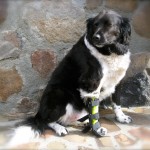OrthoVet’s splint products can stave off expensive surgery and support faster healing

As pet owners, most of us despair when our canine or feline companion sustain an orthopedic injury. Not only do we cringe at the pain our friend is suffering, but also over the high cost for treatment or surgery.
Handicapped Pets Canada and OrthoVet pet splints offer an alternative for some injuries that can cost much less than — and in some cases eliminate the need for — surgery.
Founded in 1997, OrthoVet’s goal is to provide a safe and effective option for rehabilitation of soft tissue and bone injuries of an animal’s lower leg, ankle or foot. This is the only company offering pre-fabricated splints of this type, created and designed by veterinarians and professionals in orthotics and prosthetics.
OrthoVet Vice President and co-founder Coral Anne Roeder says, “Since the splints are mass produced, it keeps the cost down compared to custom-made splints.” Serving the veterinary and companion animal rehabilitation field, OrthoVet has carved a unique niche, offering a full range of rigid, lower-leg splints in sizes ranging from feline to large-breed canines.
Roeder got into the field while working in orthotics and prosthetics for humans. One day a woman stopped in with her Doberman, who had undergone several surgeries unsuccessfully for a torn Achilles tendon. The dog was young and active, but being held back from living fully due to the injury, explained his dog mom. Roeder, donating personal time, cast his leg and created a splint that ultimately resulted in his successful recovery.
So why splint rather than cast an injury? Casting typically involves frequent bandage changes, sometimes rubbing and additional wounding, and is not waterproof — all factors that can delay healing. Splints on the other hand, are lightweight, waterproof, and user friendly — a key benefit for pup and cat parents.
Initially, the splints were often used to treat tendon and ligament weakness, and knuckling due to nerve damage. They were also used to help with limb immobilization before or after surgery. Roeder says, “Skeletal anatomy and type of injury are key factors in determining if the animal is a candidate for an OrthoVet splint.” Once a splint is determined suitable, the primary veterinarian is able to work closely with Handicapped Pets Canada and OrthoVet to ensure proper fit.
Next time you’re at your vet’s office, ask if he or she knows of this revolutionary product. Being ‘in the biz’ and as pet-obsessed as most of us are, an ounce of knowledge can go a long way when least expected. It’s also good to know the tools in your vet’s ‘toolkit.’
Stories of ACL are legion around the Spot offices, and there have been two prevailing factors in the happy endings: successfully avoiding surgery, and eventual full recovery. It’s great to discover a solution that may get all four paws back on the ground and running quickly. After all, when the pup is not happy, nobody is happy.
Article thanks to:
www.spotmagazine.net splinting-vs-surgery-no-brainer
Ortho Vet

